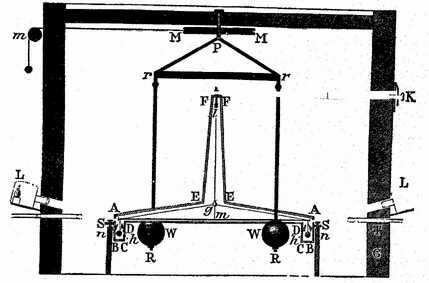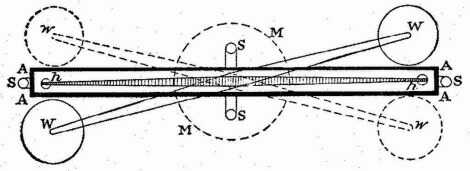Physics
CAVENDISH
The Density of the Earth
Many years ago, the late Rev. John Michell, of this Society, contrived a method of determining the density of the earth, by rendering sensible the attraction of small quantities of matter; but, as he was engaged in other pursuits, he did not complete the apparatus till a short time before his death, and did not live to make any experiments with it. After his death, the apparatus came to the Rev. Francis John Hyde Wollaston, Jacksonian Professor at Cambridge, who, not having conveniences for making experiments with it, in the manner he could wish, was so good as to give it to me. The apparatus is very simple; it consists of a wooden arm, 6 feet long, made so as to unite great strength with little weight. This arm is suspended in an horizontal position, by a slender wire 40 inches long, and to each extremity is hung a leaden ball, about 2 inches in diameter; and the whole is inclosed in a narrow wooden case, to defend it from the wind.
As no more force is required to make this arm turn round on its centre, than what is necessary to twist the suspending wire, it is plain, that if the wire is sufficiently slender, the most minute force, such as the attraction of a leaden weight a few inches in diameter, will be sufficient to draw the arm sensibly aside. The weights which Mr. Michell intended to use, were 8 inches diameter. One of these was to be placed on one side the case, opposite to one of the balls, and as near it as could conveniently be done, and the other on the other side, opposite to the other ball, so that the attraction of both these weights would conspire in drawing the arm aside; and when its position, as affected by these weights, was ascertained, the weights were to be removed to the other side of the case, so as to draw the arm the contrary way, and the position of the arm was to be again determined; consequently, half the difference of these positions would show how much the arm was drawn aside by the attraction of the weights. In order to determine from hence the density of the earth, it is necessary to ascertain what force is required to draw the arm aside through a given space. This Mr. Michell intended to do, by putting the arm in motion, and observing the time of its vibrations, from which it may easily be computed.
Mr. Michell had prepared 2 wooden stands, on which the leaden weights were to be supported, and pushed forwards, till they came almost in contact with the case; but he seems to have intended to move them by hand. As the force with which the balls are attracted by these weights is excessively minute, not more than

of their weight, it is plain that a very minute disturbing force will be sufficient to destroy the success of the experiment; and from the following experiments it will appear, that the disturbing force most difficult to guard against, is that arising from the variations of heat and cold; for if one side of the
 FIG. 28.
FIG. 28.
case be warmer than the other, the air in contact with it will be rarefied, and in consequence will ascend, while that on the other side will descend, and produce a current which will draw the arm sensibly aside. As I was convinced of the necessity of guarding against this source of error, I resolved to place the apparatus in a room which should remain constantly shut, and to observe the motion of the arm from without, by means of a telescope; and to suspend the leaden weights in such manner, that I could move them without entering into the room. This difference in the manner of observing, rendered it necessary to make some alteration in Mr. Michell’s apparatus; and as there were some parts of it which I thought not so convenient as could be wished, I chose to make the greatest part of it anew.
Fig. 28 is a longitudinal vertical section through the instrument, and the building in which it is placed: ABCDDCBAEFFE is the case; x and x are the two balls, which are suspended by the wires hx from the arm ghmh, which is itself suspended by the slender wire gl. This arm consists of a slender deal rod hmh, strengthened by a silver wire hgh; by which means it is made strong enough to support the balls, though very light. The ease is supported, and set horizontal, by 4 screws, resting on posts fixed firmly into the ground: 2 of them are represented in the figure, by S and S; the other 2 are not represented, to avoid confusion. GG and GG are the end walls of the building. W and W are the leaden weights; which are suspended by the copper rods RrPrR, and the wooden bar rr, from the centre pin Pp. This pin passes through a hole in the beam HH, perpendicularly over the centre of the instrument, and turns round in it, being prevented from falling by the
 FIG. 29.
FIG. 29.
plate p. MM is a pulley, fastened to this pin; and Mm a cord wound round the pulley, and passing through the end wall; by which the observer may turn it round, and so move the weights from one situation to the other.
Fig. 29 is a plan of the instrument. AAAA is the case; SSSS the 4 screws for supporting it; hh the arm and balls, W and W the weights; MM, the pulley for moving them. When the weights are in this position, both conspire in drawing the arm in the direction hW; but, when they are removed to the situation w and w, represented by the dotted lines, both conspire in drawing the arm in the contrary direction hw. These weights are prevented from striking the instrument, by pieces of wood, which stop them as soon as they come within

of an inch of the case. The pieces of wood are fastened to the wail of the building; and I find that the weights may strike against them with considerable force, without sensibly shaking the instrument.
In order to determine the situation of the arm, slips of ivory are placed within the case, as near to each end of the arm as can be done without danger of touching it, and are divided to 20ths of an inch. Another small slip of ivory is placed at each end of the arm, serving as a vernier, and subdividing these divisions into 5 parts; so that the position of the arm may be observed with ease to 100ths of an inch, and may be estimated to less. These divisions are viewed, by means of the short telescopes T and T, Fig. 28, through slits cut in the end of the case, and stopped with glass; they are enlightened by the lamps L and L, with convex glasses, placed so as to throw the light on the divisions; no other light being admitted to the room. The divisions on the slips of ivory run in the direction Ww, Fig. 29, so that, when the weights are placed in the positions w and w, represented by the dotted circles, the arm is drawn aside, in such direction as to make the index point to a higher number on the slips of ivory; for which reason, I call this the positive position of the weights.
FK, Fig. 28, is a wooden rod, which, by means of an endless screw, turns round the support to which the wire gl is fastened, and so enables the observer to turn round the wire, till the arm settles in the middle of the case, without danger of touching either side. The wire gl is fastened to its support at top, and to the centre of the arm at bottom, by brass clips, in which it is pinched by screws. In these 2 figures, the different parts are drawn nearly in the proper proportion to each other.
. . . . . . . . . . . . . . . . . . .
From this table it appears, that though the experiments agree pretty well together, yet the difference between them, both in the quantity of motion of the arm and in the time of vibration, is greater than can proceed merely from the error of observation. As to the difference in the motion of the arm, it may very well be accounted for, from the current of air produced by the difference of temperature; but whether this can account for the difference in the time of vibration, is doubtful If the current of air was regular, and of the same swiftness in all parts of the vibration of the ball, I think it could not; but as there will most likely be much irregularity in the current, it may very likely be sufficient to account for the difference.
By a mean of the experiments made with the wire first used, the density of the earth comes out 5.48 times greater than that of water; and by a mean of those made with the latter wire, it comes out the same; and the extreme difference of the results of the 23 observations made with this wire, is only .75; so that the extreme results do not differ from the mean by more than .38, or

of the whole, and therefore the density should seem thus to be determined, to great exactness. It may indeed be objected, that as the result appears to be influenced by the current of air, or some other cause, the laws of which we are not well acquainted with, this cause may perhaps act always, or commonly, in the same direction, and so make a considerable error in the result. But yet, as the experiments were tried in various weathers, and with considerable variety in the difference of temperature of the weights and air, and with the arm resting at different distances from the sides of the case, it seems very unlikely that this cause should act so uniformly in the same way, as to make the error of the mean result nearly equal to the difference between this and the extreme; and therefore it seems very unlikely that the density of the earth should differ from 5.48 by so much as

of the whole.
Another objection perhaps may be made to these experiments, namely, that it is uncertain whether, in these small distances, the force of gravity follows exactly the same law as in greater distances. There is no reason however to think that any irregularity of this kind takes place, until the bodies come within the action of what is called the attraction of cohesion, and which seems to extend only to very minute distances. With a view to see whether the result could be affected by this attraction, I made the 9th, 10th, 11th, and 15th experiments, in which the balls were made to rest as dose to the sides of the case as they could; but there is no difference to be depended on, between the results under that circumstance, and when the balls are placed in any other part of the case.
According to the experiments made by Dr. Maskelyne, on the attraction of the hill Schehallian, (See A Source Book in Astronomy, p. 133.) the density of the earth is 4½ times that of water; which differs rather more from the preceding determination than I should have expected. But I forbear entering into any consideration of which determination is most to be depended on, till I have examined more carefully how much of the preceding determination is affected by irregularities whose quantity I cannot measure.